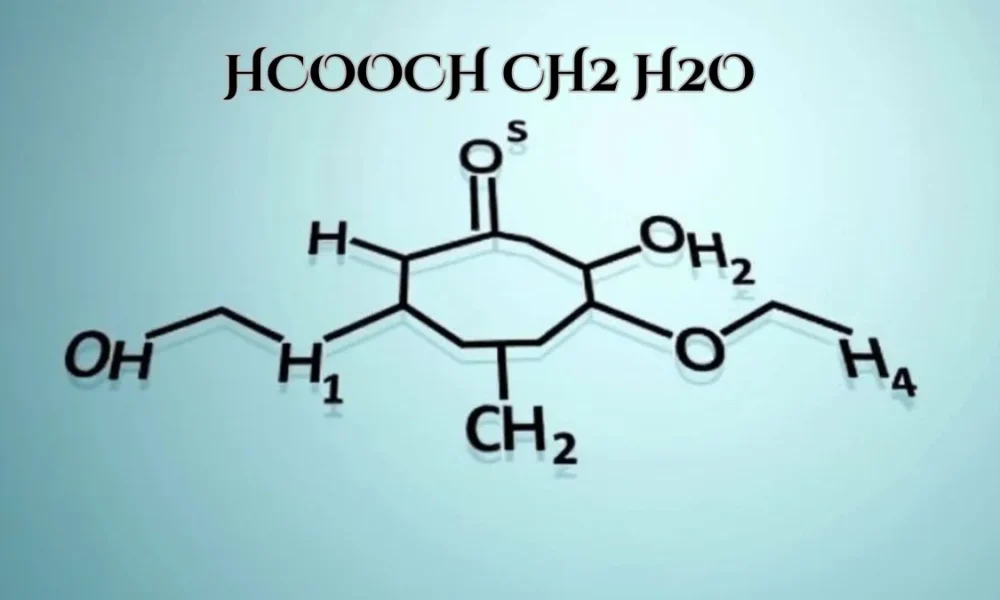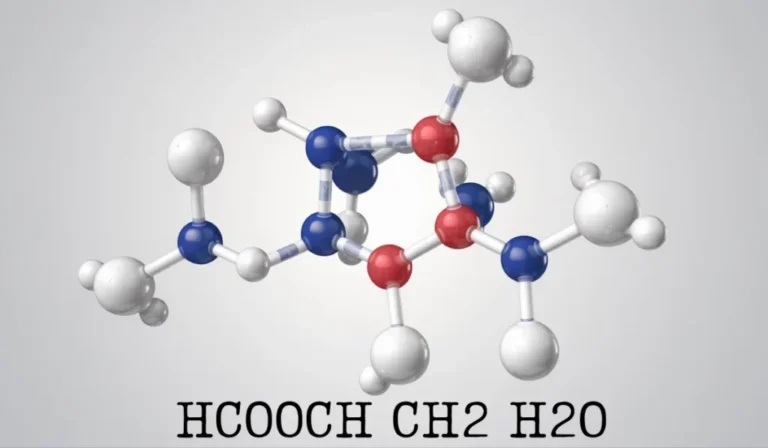HCOOCH CH₂ H₂O describes the interaction of methyl formate (HCOOCH₃), methylene fragment (CH₂), and water (H₂O). This combination defines the ester hydrolysis pathway where methyl formate reacts with water to form methanol and formic acid. It connects industrial chemistry, organic reaction mechanisms, and environmental science.

Understanding the Chemical Components:
Methyl Formate (HCOOCH₃):
-
Methyl formate is the methyl ester of formic acid.
-
Molecular formula: C₂H₄O₂.
-
Physical state: colorless, volatile liquid with ether-like odor.
-
Applications: solvent, intermediate for formic acid, foam blowing agent.
CH₂ Fragment:
-
CH₂ is a methylene group.
-
It appears in organic structures as a two-hydrogen carbon unit.
-
In hydrolysis, it belongs to the methanol by-product.
-
It connects ester chemistry to alcohol formation.
Water (H₂O):
-
Water acts as the universal solvent and nucleophile.
-
It drives hydrolysis reactions.
-
It determines equilibrium direction in ester systems.
-
It is abundant, safe, and cost-efficient.
Balanced Reaction of HCOOCH CH₂ H₂O:
The hydrolysis equation is:
HCOOCH₃ + H₂O → HCOOH + CH₃OH
-
Reactants: methyl formate and water.
-
Products: formic acid and methanol.
-
Reaction type: ester hydrolysis.
-
Pathway: nucleophilic substitution at carbonyl carbon.
Mechanism of Hydrolysis:
Acid-Catalyzed Hydrolysis:
-
Protonation of ester carbonyl oxygen.
-
Increase in carbonyl electrophilicity.
-
Water attacks carbonyl carbon.
-
Tetrahedral intermediate forms.
-
Methanol leaves.
-
Formic acid forms.
Base-Catalyzed Hydrolysis:
-
Hydroxide attacks carbonyl carbon.
-
Intermediate forms.
-
Methoxide ion departs.
-
Methoxide converts to methanol.
-
Formate ion protonates.
-
Formic acid forms.
Key Properties of Compounds:
| Compound | Formula | Molar Mass (g/mol) | Boiling Point (°C) | Density (g/cm³) | Notable Hazard |
|---|---|---|---|---|---|
| Methyl Formate | C₂H₄O₂ | 60.05 | 31.5 | 0.97 | Flammable, irritant |
| Water | H₂O | 18.02 | 100 | 1.00 | None in normal conditions |
| Formic Acid | HCOOH | 46.03 | 100.8 | 1.22 | Corrosive, skin burns |
| Methanol | CH₃OH | 32.04 | 64.7 | 0.79 | Toxic, flammable, blindness |
Industrial Applications of Hydrolysis:
-
Production of formic acid for leather tanning and textiles.
-
Recycling of methanol for biodiesel production.
-
Use in pharmaceutical intermediates and pesticides.
-
Application in green chemistry as a recyclable route.
Environmental Impact of HCOOCh CH2 H2O:
-
Hydrolysis occurs naturally in water.
-
Products, formic acid and methanol, degrade quickly.
-
Biodegradation integrates into the carbon cycle.
-
Low persistence ensures reduced ecological risk.
Safety Considerations:
-
Methyl formate vapors are explosive.
-
Methanol ingestion causes blindness and death.
-
Formic acid corrodes skin and tissue.
-
Protective gear and closed systems are essential.
Industrial Uses of Products:
-
Formic acid in silage preservation.
-
Methanol in formaldehyde synthesis.
-
Methanol in direct fuel cells.
-
Formic acid in rubber coagulation.
-
Methanol in antifreeze solutions.
Research Trends in HCOOCH₃ Hydrolysis:
-
Exploration of enzyme-based catalysts.
-
Development of solid acid catalysts.
-
Modeling of autocatalytic kinetics.
-
Integration into bio-refinery systems.
-
Use of green solvents in hydrolysis.
FAQs About HCOOCH CH₂ H₂O:
Q1: What is HCOOCH CH₂ H₂O?
It is shorthand representing the hydrolysis of methyl formate (HCOOCH₃) with water (H₂O), involving CH₂ as part of the methanol product.
Q2: What products are formed in this reaction?
The products are formic acid (HCOOH) and methanol (CH₃OH).
Q3: Why is this reaction important industrially?
It produces formic acid, a high-demand chemical, and methanol, a versatile industrial solvent and fuel precursor.
Q4: Does this reaction occur in the environment?
Yes, hydrolysis of methyl formate in natural water bodies forms methanol and formic acid, which then degrade biologically and chemically.
Q5: What are the hazards of handling HCOOCH₃?
It is flammable, volatile, and irritating. Proper safety controls and protective equipment are required.
Conclusion:
HCOOCH CH2 H2O represents far more than a simple chemical shorthand. At its core, it describes the ester hydrolysis of methyl formate with water, a reaction that generates two highly significant products formic acid and methanol. This single reaction pathway connects fundamental organic chemistry with applied industrial processes, environmental dynamics, and future research directions, making it a critical area of focus across multiple scientific disciplines.
The importance of this hydrolysis lies in its universality. In laboratories, it serves as a clear example of nucleophilic substitution at a carbonyl carbon, illustrating acid-catalyzed, base-catalyzed, and even autocatalytic mechanisms. In industries, it forms the backbone of large-scale production of formic acid, a compound essential for agriculture, textiles, pharmaceuticals, and silage preservation. Simultaneously, methanol, the co-product, supports fuel technology, plastics manufacturing, and alternative energy research, giving the reaction immense commercial weight.
From an environmental perspective, the chemistry of HCOOCH CH₂ H₂O underscores the natural degradability of esters. Methyl formate does not persist indefinitely in ecosystems; it hydrolyzes into methanol and formic acid, both of which continue to break down into smaller, biologically compatible compounds such as carbon dioxide. This cycle demonstrates how chemical processes intersect with ecological balance, reducing long-term environmental risks and supporting sustainability.

